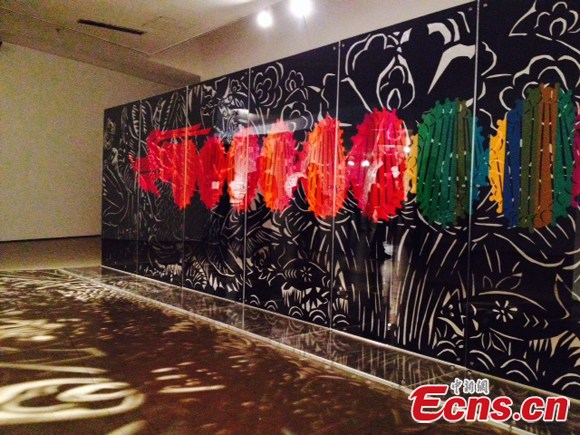 |
|
Chinese artist Qiao Xiaoguang's work Fish and Dragon Change uses paper, light and shadow to describe a time of change. [Photo: ECNS]
|
Two artists from different countries find a common theme and communicate with each other and the audience with paper cutting.
The ongoing exhibition at the Today Art Museum, titled Paper Dialogues – The Dragon and Our Stories, is a collaborated project by Chinese artist Qiao Xiaoguang and Scandinavian artist Karen Bit Vejle to present the myths of the dragon in their cultures.
Qiao's paper-cut is a nine meter long frieze titled Fish and Dragon Change that can be seen from both sides. He uses the black color on the front side to symbolize chaos and renewal, and colors of the rainbow on the back side to represent a time of change. His work is an analogy describing the changes in the Chinese society, people and his own life.
Bit's work consists of seven egg-shaped paper-cuts that represent the past, the present and the future. The work focuses on the dragon as a creature that drives away evil spirits and the dragon of the future that guards new things of value, such as knowledge and peace. Each of the seven paper-cuts contains numerous figures, symbols and complex patterns to tell stories of ancient myths.
The art of paper cutting originates in China more than 1,500 years ago. In 2009, the Chinese paper cutting tradition was included on UNESCO's Intangible Cultural Heritage List. It's also an important folk art in Denmark, where Bit was born.
Although the dragon has different connotations – auspicious and powerful in Chinese culture and guard of treasures in Scandinavian culture, the two artists overcome language and cultural barriers to represent history, myths and culture with exquisite paper-cutting skills.
Sam Shi, a Tsinghua University student majoring in architecture preservation, said he was marveled at the artworks.
"I'm amazed at the technique, as asymmetrical paper cutting can be very complicated and challenging," he said. Shi also said he's glad to have the opportunity to appreciate intangible cultural heritage.
Norwegian Ambassador to China Svein Ole Sæther said the exhibition is a good example of bridging cultural differences via arts.
"The key word here is dialogue. Through dialogue between people, cultures and nations, we discover and appreciate the things we have in common, and the things we differ from each other." Sæther said.
We Recommend:
